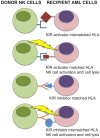Graft-versus-Leukemia Effect Following Hematopoietic Stem Cell Transplantation for Leukemia
- PMID: 28638379
- PMCID: PMC5461268
- DOI: 10.3389/fimmu.2017.00496
Graft-versus-Leukemia Effect Following Hematopoietic Stem Cell Transplantation for Leukemia
Abstract
The success of hematopoietic stem cell transplantation (HSCT) lies with the ability of the engrafting immune system to remove residual leukemia cells via a graft-versus-leukemia effect (GvL), caused either spontaneously post-HSCT or via donor lymphocyte infusion. GvL effects can also be initiated by allogenic mismatched natural killer cells, antigen-specific T cells, and activated dendritic cells of leukemic origin. The history and further application of this GvL effect and the main mechanisms will be discussed and reviewed in this chapter.
Keywords: LAA specific T cells; allogenic natural killer cells; animal models; donor lymphocyte infusion; graft-versus-leukemia effect; invariant natural killer T cells (i)NKT; leukaemia associated antigens (LAA); leukaemia derived dendritic cells; leukaemia specific antigens.
Figures



References
-
- Santos GW, Sensenbrenner LL, Burke PJ, Mullins GM, Blas WB, Tutschka PJ, et al. The use of cyclophosphamide for clinical marrow transplantation. Transplant Proc (1972) 4(4):559–64. - PubMed
-
- Thomas ED, Epstein RB. Bone marrow transplantation in acute leukemia. Cancer Res (1965) 25(9):1521–4. - PubMed
-
- Sensenbrenner LL, Steele AA, Santos GW. Recovery of hematologic competence without engraftment following attempted bone marrow transplantation for aplastic anemia: report of a case with diffusion chamber studies. Exp Hematol (1977) 5(1):51–8. - PubMed
-
- Thomas ED, Buckner CD, Banaji M, Clift RA, Fefer A, Flournoy N, et al. One hundred patients with acute leukemia treated by chemotherapy, total body irradiation, and allogeneic marrow transplantation. Blood (1977) 49(4):511–33. - PubMed
Publication types
LinkOut - more resources
Full Text Sources
Other Literature Sources

